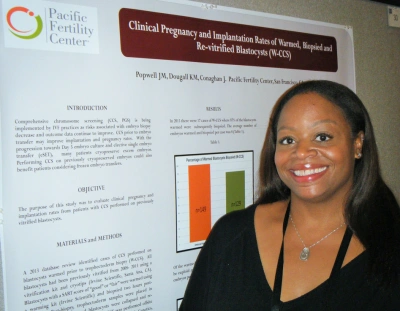
Jean's 2014 PCRS Poster
With the progression towards Day 5 embryo culture and eSET (elective single embryo transfer), several patients have a large number of excess frozen blastocyst (day 5) embryos using the most current technology for freezing called vitrification. In our laboratory, vitrification provides a faster, better method of freezing resulting in higher embryo survival and pregnancy rates.
Currently at PFC, we provide our patients with the option of having their Day 5 embryos biopsied to determine the genetic status before transfer in a subsequent frozen embryo transfer (FET). The embryo biopsy allows for comprehensive chromosome screening (CCS) of embryos thus determining which embryos have the correct chromosome number (euploid) and are suitable for transfer. The combination of CCS and eSET in an FET has been shown in our laboratory to improve both implantation and pregnancy rates while reducing the multiple birth rate.
Recently, patients from 2008 to 2013 who previously chose to have their extra embryos frozen after fresh transfer have requested to have their frozen embryos undergo CCS before their next FET cycle. So the purpose of this study was to evaluate both clinical pregnancy and implantation rates from patients with CCS performed on previously vitrified blastocysts (W-CCS).
In 2013 there were 17 cases in which blastocyst embryos were thawed (warmed), biopsied and then re-vitrified. Of the warmed blastocysts, 87% were subsequently biopsied and vitrified. Of the biopsied blastocysts, 67% were found to be euploid and 33% aneuploid (chromosomally abnormal). Subsequently, 13 FETs were performed with four cases still pending. In these 13 FETs, 15 blastocysts were re-warmed and transferred, 11 eSET and 2 double embryo transfers. In this study, the clinical pregnancy rate (62%) and implantation rate (60%) were highly comparable to our overall 2012 clinic rates for FETs using standard CCS techniques with fresh blastocysts (clinical pregnancy rate 62% and implantation rate 61%).
This data demonstrates that CCS has the potential to be performed on previously vitrified blastocysts (W-CCS) with positive clinical outcomes and that transfer of chromosomally normal blastocysts screened following W-CCS yields pregnancy and implantation rates comparable to CCS performed on fresh blastocysts. More importantly, knowledge of the chromosome status of frozen embryos will benefit both clinicians and patients when evaluating embryo transfer and embryo disposition options.
Jean M. Popwell, PhD, HCLD, CC
Senior Embryologist
PFC IVF Laboratory
Categories
About the Blog
Welcome to the Pacific Fertility Center Blog! Nationally and internationally recognized for providing exceptional reproductive care, our team believes in empowering people with the knowledge they need to navigate their unique fertility journeys.
From information on the latest fertility treatments to valuable insights on egg donation, surrogacy, and everything in between, the Pacific Fertility Center Blog is your ultimate resource for all things reproductive care and support. Read on to learn more, and contact us today if you have any questions or want to schedule a new patient appointment.

